ASTROPHYSICS: Explaining the Sun in more detail and the evidence about the nature of the Solar System.
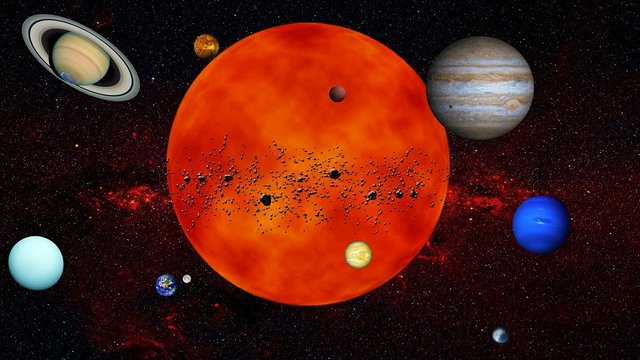 )
) )
)The intensity of the absorption lines for an element can tell us how much of the element is present: the more of the element that is at the surface, the more absorption takes place and the darker the line. Such measurements show that the Sun's atmosphere consists of 72 per cent hydrogen, 26 per cent helium and 2 per cent of what astronomers call heavy elements, those with more than two protons in the nucleus!
THE SUN AS AN ENERGY SOURCE
The Sun obtains its energy from nuclear fusion. In this process, positively charged nuclei collide with each other with enough kinetic energy to overcome the energy barrier produced by the electric repulsion forces between them. For this to happen, the particles have to be travelling at very high speeds, which are reached by a tiny fraction of the particles at any moment only when the temperature is more than about 107 K. The Sun's core is estimated to have temperatures in the range 0.8 to 1.6 × 107 K.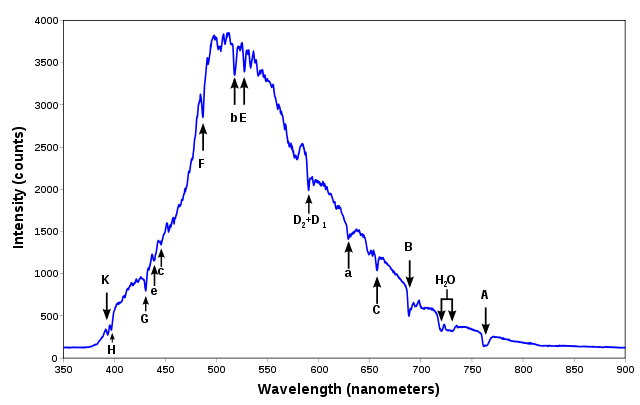 )
)Nuclei are very small, and fusion reactions will be a continuous source of energy only when a plasma is at a density that is high enough for a sufficiently high rate of collisions. The plasma in the active core of the Sun is at high pressure and has a density 160 times that of water, 1.6 ×105 kg m-3. This is high enough to maintain the reactions.
THE SOLAR FUSION REACTIONS
The fusion process that converts hydrogen to helium in the Sun is the proton-proton chain. This is the basic energy producing process in most stars. It is called 'hydrogen burning', but is not the ordinary kind of burning (oxidation). The key reaction is the most difficult to 'arrange': two protons collide and stick together long enough for one of them to convert to a neutron. It does this by emitting a positron and a neutrino. The positron soon collides with a passing electron and they annihilate each other to form a pair of photons. The neutrino escapes in seconds as it has a very low probability of absorption by matter. The proton-neutron duo is deuterium, a fairly stable isotope of hydrogen. It lasts long enough for further collisions to take place.
The process is described below. In a situation where two deuterium nuclei merge. The net result is that 4 protons become 2 protons and 2 neutrons, and 2 new positrons annihilate 2 electrons.
The most likely proton-proton reaction
This starts with deuterium as described in the main text. What happens next depends on the precise conditions in the core. The most likely is a collision between deuterium and another proton to form helium-3. This then collides with helium-4 nucleus, resulting in the formation of Beryllium-7. which in turn picks up a proton to Boron-8. Boron-8 is unstable and emits a positron and neutrino to make beryllium again, now as Be-8.This too is unstable but undergoes fission to make two helium-4 nuclei
1p + 1p → 2H + e+ + v :(2 protons used)
2H + 1p → 3He + γ :(1 proton used)
3He + 4He → 7Be + γ
7Be + 1p → 8B :(1 proton used)
8B → 8Be + e+ + v
8Be → 4He + 4He
As in the simple process four protons combine to make one helium nucleus and two positrons are created for Swift annihilation.
The Sun In Equilibrium
The Sun is in equilibrium, balancing its internal gas pressure against the force of gravity, and any changes are self-correcting. If the fusion reaction slowed down for some reason, the core would cool slightly and its particles would cause a smaller pressure. The force of gravity would cause a small collapse, and this would increase the temperature as gravitational potential energy becomes random kinetic energy. In turn, the rate of energy production by nuclear reactions would increase, the pressure of the hotter plasma would also increase, and so the balance would be restored.THE INTERNAL STRUCTURE OF THE SUN
We can only observe the visible surface of the Sun (its photosphere) and have to deduce its internal structure by computer modelling using observations and calculations. It was actually observed at the surface that there are three main regions in the Sun: the energy generating core, an energy-transmitting zone and an outer atmosphere.
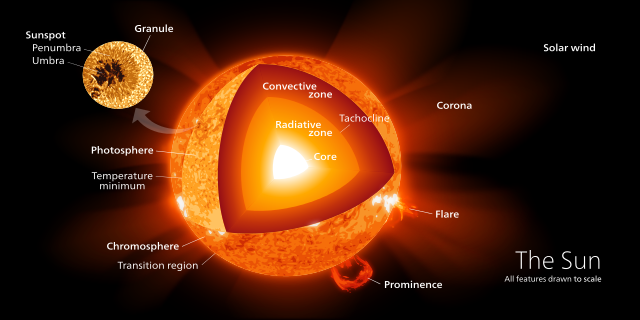 )
)The core is the site of the nuclear fusion reactions which provide the energy of the Sun. This energy travels to the surface first as radiation and then as convection currents in the cooler gases of the outer layers.
High energy photons emerging from the core first supply energy to the gas of the radiation layer, making it hotter, but losing energy themselves as they do so. The heated gas expands and rises to form convection currents, just like water in a pan on a hot stove, in the convection zone.
This zone has a temperature which is low enough for hydrogen and helium atoms to form. Photons are still there as carriers of energy, but energy can be transported more quickly by convection than by photons. This is because the photons leaving the core are easily absorbed, by exciting or ionising the atoms. The convection zone is therefore opaque.
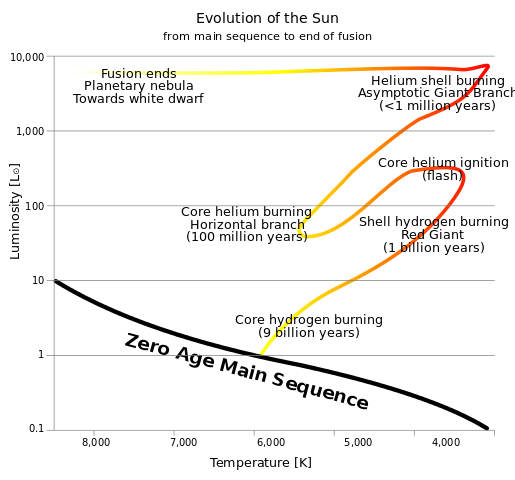 )
)Convection ceases where the Sun's atmosphere becomes too thin. Energy now leaves the Sun as radiation, which means that it is the top of the convection zone that we actually see from Earth - the photosphere. It has a granular structure of light and dark areas when photographed using a filter which passes only the light from very hot hydrogen.
The Sun has two regions outside the photosphere, which can be seen only during an eclipse of the Sun. Next to the photosphere is the chromosphere, a very thin region of low density. It is seen as a flash of bright pink hydrogen light at the start of a solar eclipse. At total eclipse, we can see yet another zone of light-emitting gas, the corona. It is at a temperature of 500,000 K or so, and emits bright lines from highly ionised atoms such as neon, calcium, iron and nickel, in addition to hydrogen. The shape of the corona suggests that magnetic fields are involved.
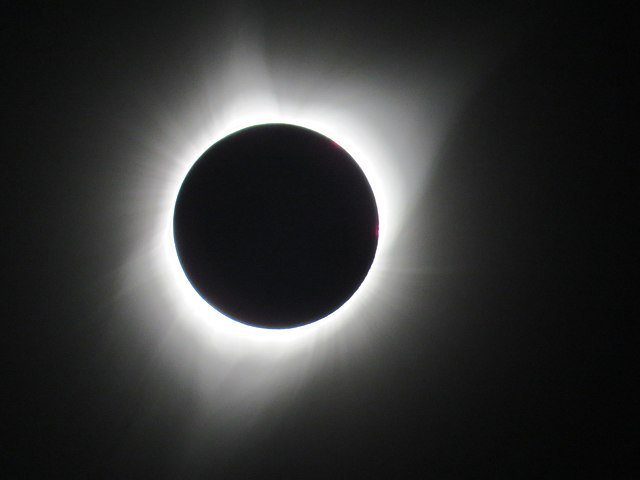 )
) )
)HOW LONG WILL THE SUN LAST?
The core of the Sun is believed to consist of helium and hydrogen in the ratio 60 per cent helium to 40 per cent hydrogen. Only about 10 per cent of the Sun's total mass of hydrogen is in the core. These are computer estimates as it is impossible to measure the amounts of hydrogen and helium at different levels in the Sun's interior. When the available hydrogen of the core is converted into helium, the proton-proton reaction will stop. The Sun as we know it will cease to exist - but I'll discuss vividly in my next post on what's next when such an occurrence happens.
Computer models estimate that about 1 × 1029 kg of hydrogen is present in the core for conversion to helium. But only 0.7 per cent of the hydrogen's mass can be converted to radiation energy by way of the fusion reaction; the rest remains as helium. This means that the mass actually available for energy to keep the Sun going is reduced to 7 × 1026 kg.
We know that the Sun emits energy at the rate of 3.9 × 1026 W, or 1.2 × 1034 J per year. This is equivalent to a mass loss of:
Δm = E/c2
= 1.2 × 1034/9 × 1016
= 1.33 × 1017 kg per year
Thus, at a rough estimate, the Sun will use up its core hydrogen in:
(7 × 1026)/(1.33 × 1017)
= 5 × 109 years.
THE EVIDENCE: TELESCOPES IN MODERN ASTRONOMY
We gain evidence about the nature of the Solar System and the wider Universe of stars, nebulas and galaxies by collecting information from the electromagnetic spectrum that reaches us from space. Until recently, all our telescopes have been ground-based, so this information has been filtered by the Earth's atmosphere. The atmosphere is transparent only to certain parts of the spectrum, absorbing almost all infrared, as well as X- and ultraviolet radiation. It also adds unwanted signals called 'noise' to other parts of the spectrum.
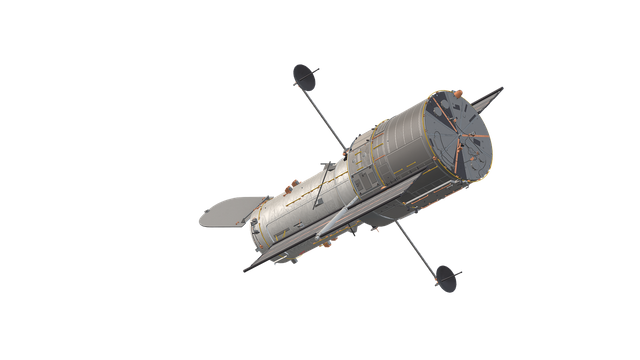 )
)TURBULENCE, TWINKLING AND 'SEEING'
Turbulence in pockets of air in the upper atmosphere affects light from stars, so that they seem to 'twinkle' like I've explained in one of my previous post [Astrophysics: The physics of astronomical objects](https://www.steemstem.io/#!/@emperorhassy/astrophysics-the-phy-1556206989).Seeing problems can be best (but expensively) avoided by using Earth satellites as platforms for instruments capable of detecting radiations at all frequencies. The most powerful instrument of this kind is the Hubble Space Telescope, launched in 1990, which has added greatly to our knowledge of stars and understanding of the Universe at large.
OPTICAL TELESCOPES
The basic physics of telescopes will be explained and discussed in some of my next post. Nevertheless, the simple Newtonian reflector is the most commonly used optical telescope. The image is formed on a photographic plate or (more often nowadays) by an electronic detector.
The image is never perfect. There are three main problems:
• Diffraction produces a circular pattern rather than a point image of a star (or other object). • "Seeing" gives loss of detail when air currents in the atmosphere cause random motion of the image that reaches the detector. • "Grain" results because the detecting device has a lower limit to the size of the object it can detect. This can be because of the size of the grains in light-sensitive chemical in a photographic plate, or the pixel charge-coupled detector.RADIO TELESCOPES
There are two main types of radio telescope, those with dish aerials and those with arrays of linear aerials.Dish telescopes work in much the same way as reflecting telescopes, in that they gather as much of the signal as possible at as great a resolution as possible. They work at wavelengths which are very much longer than light, and the detector is a tuned circuit, as opposed to the photographic plate of an optical telescope.
One of the largest dish aerial is in a natural hollow ground at Arecibo in Puerto Rico. It has a diameter of 305 m. This telescope can only detect signals that enter it from overhead, so can only record whatever is above it as the Earth rotates. Steerable telescopes can point to any object above their horizon but have to be smaller. The largest is a 100m diameter dish at the Max Planck Institute near Bonn in Germany.
Diffraction
Diffraction limits the accuracy with which any telescope can determine the position of an object. A dish of 100 wavelengths diameter can position an object within a region 1 degree wide, which is very much larger than the angular size of a star. Radio astronomy often uses the radio signal from molecular hydrogen at a wavelength of 0.21 m.This means that the early radio telescopes with dishes about 25 m or even 50 m wide could not pinpoint the positions of radio stars - stars emitting radio waves - accurately enough to match them with likely visible sources. A group of stars may be as close as 0.5 seconds of arc, and to separate their images would require a dish 50,000 wavelengths in diameter.
Receiving power
The larger the dish, the more energy the telescope can receive per second. This receiving power is simply proportional to the area of the dish. i.e receiving power ∝ (dish diameter)2.Arrays of dish aerials
Small dishes give much better resolution when they are linked in arrays. This also increases the area of the receiving system and hence the receiving power.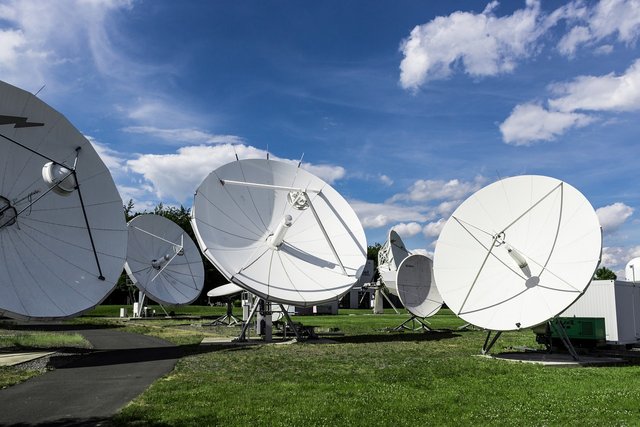 )
)Reflector smoothness
The dish of a radio telescope is made of metal which reflects radio signals in much the same way that a silvered surface reflects light. The surface need not be solid: in fact, it is usually a wire mesh, which is as good as a continuous metal surface provided that the gaps between the wires are less than one-twentieth of the shortest wavelength detected.LINE AERIALS
A simple aerial is a metal wire in which a signal voltage is induced when electromagnetic waves pass it, due to the electric component of the wave. The signal is strongest when the length of the aerial is matched to the length of the electromagnetic wave. Then, there is resonance between the signal voltage and the wave that is being received. Such an aerial is 'tuned'. Everyday examples are the dipole aerials used for VHF radio and UHF TV reception.Modern computer programs improve the radio image by adding up signals obtained at different times, enhancing the true signal and cancelling out noise. Thousands of simple dipole line aerials can be connected together to give a non-steerable array, which makes a cheap but very sensitive system with good resolution. It was an array like this at Cambridge that detected the first pulsar to be discovered.
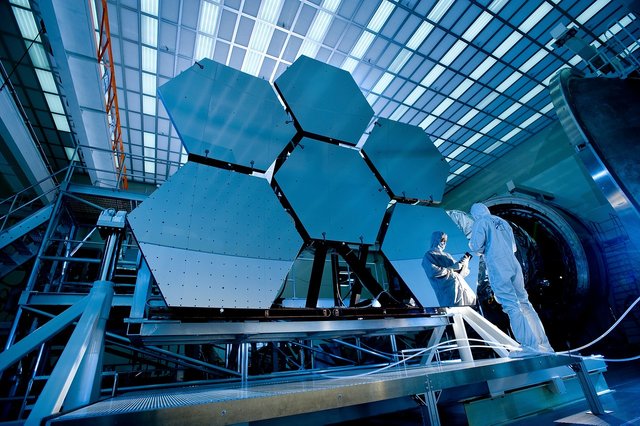 )
)SPECIALIST TELESCOPES: GAMMA RAY ULTRAVIOLET AND INFRARED
Atmospheric absorption severely limits the use of ultraviolet, X-rays and infrared for observation, so balloons, high flying aircraft, space laboratories and satellites have been used to collect data in these regions of the spectrum.X-ray telescopes have been carried in the Uhuru satellite (launched in 1970, the first to carry an X-ray telescope), the ROSAT satellite in 1990, and several others. It is difficult to focus X-rays as they tend to go straight through materials or get absorbed in them. An ordinary mirror reflector is as useless as a lens would be. Instead, they are focused to a detector by a set of slightly angled cylindrical surfaces which they reach at grazing angles. As observed, X-ray sources are closely linked with detecting the existence of black holes.
Gamma rays are more penetrating than X-rays and reach ground level. There is a gamma ray telescope 10 m in diameter at the Whipple Observatory in Arizona, and NASA used the Space Shuttle to launch the Gamma Ray Observatory in 1991.
Hot stars - those with surface temperatures greater than 10,000 K - emit most of their energy as ultraviolet radiation. This region gives the most useful spectral lines for studying the composition of very hot stars and regions of space where new stars are being formed. Ultraviolet is strongly absorbed in the atmosphere, so most research uses satellite-borne telescopes. The Hubble Space Telescope also contains an ultraviolet instrument.
Ground-based infrared astronomy uses the narrow bands of wavelengths not absorbed by the atmosphere's carbon dioxide and water vapour. The electronic devices used to detect infrared have to be cooled close to absolute zero (about 2.5 K).
In 1983, IRAS, the Infrared Astronomical Satellite, mapped the whole sky at wavelengths between 12 and 57 μm. It detected some 250,000 infrared sources, identified as stars, galaxies and gas clouds. Five comets were also discovered. Some strong infrared sources are believed to be regions of space rich in gas and dust in which young stars are forming. The gravitational collapse of the cloud causes it to heat up.
In my next post, I shall be discussing more on astronomical distances of the solar system and the death of stars. Till then, I remain my humble self, @emperorhassy.
Thanks for reading.
 )
)
REFERENCES
[Fraunhofer lines - Wikipedia https://en.m.wikipedia.org › wiki › Fraun...](https://www.google.com/url?sa=t&source=web&rct=j&url=https://en.m.wikipedia.org/wiki/Fraunhofer_lines&ved=2ahUKEwj6meWdtZTiAhXk0eAKHW6nB7kQFjAVegQIBBAB&usg=AOvVaw38UrqVTBd4wn6Jc2J8y_Kj) [The Composition of the Sun | NASA https://www.nasa.gov › topnav › listbytype](https://www.google.com/url?sa=t&source=web&rct=j&url=https://www.nasa.gov/audience/foreducators/topnav/materials/listbytype/The_Composition_of_the_Sun.html&ved=2ahUKEwjJub_WtJTiAhUi6uAKHXRlBxcQFjAfegQIAxAB&usg=AOvVaw1nSWE6dTe5_L7GlctroGwf) [What Is the Sun Made Of? Table of Element Composition - ThoughtCo https://www.thoughtco.com › element-co...](https://www.google.com/url?sa=t&source=web&rct=j&url=https://www.thoughtco.com/element-composition-of-sun-607581&ved=2ahUKEwjJub_WtJTiAhUi6uAKHXRlBxcQFjAdegQIBxAB&usg=AOvVaw0Cw0KjWvkzy5xNin7nv4xY) [What elements make up the Sun? (Beginner) - Curious About Astronomy ... curious.astro.cornell.edu › composition](https://www.google.com/url?sa=t&source=web&rct=j&url=http://curious.astro.cornell.edu/our-solar-system/53-our-solar-system/the-sun/composition/202-what-elements-make-up-the-sun-beginner&ved=2ahUKEwjJub_WtJTiAhUi6uAKHXRlBxcQFjAcegQIAhAB&usg=AOvVaw2ytDw-Op5z-rL2-Uxbxeov) [Structure and Composition of the Sun YouTube · Launch Pad Astronomy Oct 29, 2017](https://www.google.com/url?sa=t&source=web&rct=j&url=%23&ved=2ahUKEwjJub_WtJTiAhUi6uAKHXRlBxcQwqsBMBp6BAgIEAU&usg=AOvVaw0VTJzWxrN8ZFOD4xbU2nov) [Composition of the Sun hyperphysics.phy-astr.gsu.edu › suncomp](https://www.google.com/url?sa=t&source=web&rct=j&url=http://hyperphysics.phy-astr.gsu.edu/hbase/Tables/suncomp.html&ved=2ahUKEwjJub_WtJTiAhUi6uAKHXRlBxcQFjAZegQIBBAB&usg=AOvVaw1qcluh1HOe16evrAzV-ue-) [How to describe the composition of the ... https://www.quora.com › How-can-you-...](https://www.google.com/url?sa=t&source=web&rct=j&url=https://www.quora.com/How-can-you-describe-the-composition-of-the-Sun&ved=2ahUKEwjJub_WtJTiAhUi6uAKHXRlBxcQFjAYegQIBhAB&usg=AOvVaw3aS1AgzGCgDa4HVSRmB0e8) [What Is Our Sun Made Of? | Space https://www.space.com › 14745-...](https://www.google.com/url?sa=t&source=web&rct=j&url=https://www.space.com/amp/14745-sun-composition.html&ved=2ahUKEwjJub_WtJTiAhUi6uAKHXRlBxcQFjAXegQICRAB&usg=AOvVaw05ZwvnbJd7ukUDq5Z6tXgW&cf=1) [Sun - Wikipedia https://en.m.wikipedia.org › wiki › Sun](https://www.google.com/url?sa=t&source=web&rct=j&url=https://en.m.wikipedia.org/wiki/Sun&ved=2ahUKEwjJub_WtJTiAhUi6uAKHXRlBxcQFjAWegQIChAB&usg=AOvVaw3P546pNxmgKya1gWNMlush) [The Structure and Composition of the Sun | Astronomy - Lumen Learning https://courses.lumenlearning.com › the-s...](https://www.google.com/url?sa=t&source=web&rct=j&url=https://courses.lumenlearning.com/astronomy/chapter/the-structure-and-composition-of-the-sun/&ved=2ahUKEwjJub_WtJTiAhUi6uAKHXRlBxcQFjAVegQIARAB&usg=AOvVaw1DdzqPgBC4DIW67-JAzNMT) [What Is Our Sun Made Of? | Space](https://www.google.com/url?sa=t&source=web&rct=j&url=https://www.space.com/14745-sun-composition.html&ved=2ahUKEwjJub_WtJTiAhUi6uAKHXRlBxcQwaICMAx6BAgNECw&usg=AOvVaw0MfPpwNKjhlETgNNSbIfo4)  )
)
Make sure to follow steemstem on steemstem.io, steemit, facebook, twitter, and instagram to always be up-to-date on our latest news and ideas.
Please also consider to support the project by delegating to @steemstem for a ROI of 65% of our curation rewards (quick delegation links: 50SP | 100SP | 500SP | 1000SP | 5000SP | 10000SP).
Follow us || Vote for the SteemSTEM Witness || Visit our new home steemstem.io
 )
)
 )

 )
Image credit: @hightouch
)
Image credit: @hightouch
Hello @emperorhassy your article is great, it only has some small details with the format, try to correct them, for example when you are going to place the sources of some images the link is incorrect. Of rest the subject is very interesting
Hi @carloserp-2000, thanks for the compliment. But as regards the format of the post, I and some other writers have complained about the problem several times. Whenever I write a post on steemit.com (because you can only write but can't save as a draft on steemstem.io), and then transfer to steemstem.io, I notice that the format changes especially the image sources and references.
Kindly view the post on steemstem.io just like @greenrun has suggested and you would see the difference and understand my concern.
Thanks.
f in the application it looks good, when you go to write your next post you can contact me in discord and I help you with the format so that it is visualized well in both steemstem.io and in the steemit, I can give you some tips of commands HTML @emperorhassy
Thanks, @carloserp-2000. I'll contact you on discord.
It looks great at https://www.steemstem.io/ :)
Thanks, @greenrun. But do you think there's a way I can go about making the post's format beautiful both on steemit.com and steemstem.io?
I guess @carloserp-2000 got you covered :)
Alright, then.
Hi @emperorhassy!
Your post was upvoted by Utopian.io in cooperation with @steemstem - supporting knowledge, innovation and technological advancement on the Steem Blockchain.
Contribute to Open Source with utopian.io
Learn how to contribute on our website and join the new open source economy.
Want to chat? Join the Utopian Community on Discord https://discord.gg/h52nFrV
This post has been voted on by the SteemSTEM curation team and voting trail. It is elligible for support from @curie and @utopian-io.
If you appreciate the work we are doing, then consider supporting our witness stem.witness. Additional witness support to the curie witness and utopian-io witness would be appreciated as well.
For additional information please join us on the SteemSTEM discord and to get to know the rest of the community!
Thanks for having added @steemstem as a beneficiary to your post. This granted you a stronger support from SteemSTEM.
Thanks for having used the steemstem.io app. You got a stronger support!
Congratulations @emperorhassy! You have completed the following achievement on the Steem blockchain and have been rewarded with new badge(s) :
You can view your badges on your Steem Board and compare to others on the Steem Ranking
If you no longer want to receive notifications, reply to this comment with the word
STOPDo not miss the last post from @steemitboard: